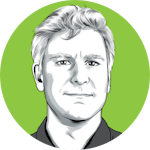The letter to a Minnesota senator from the CIA expressed regret. The nation's storied intelligence agency was at a loss to explain how the Rev. James Francis Carney, an American Jesuit priest turned radical revolutionary, disappeared in the misty jungles of Honduras.
"Unfortunately, the documents in our files give no conclusive evidence as to the fate of Father Carney," a CIA official, John Moseman, wrote to then-Sen. Paul Wellstone in January 1998.
The family and friends of Carney, some of whom lived in Minnesota, did not believe it then, and they don't believe it today. So they continue their three-decade quest to force the government to reveal everything it knows about one of the most enduring mysteries of U.S. foreign policy in Central America.
Despite four Freedom of Information Act lawsuits, congressional hearings and a presidential promise of transparency, key records held by the CIA and other agencies that could shed light on what happened to Carney in September 1983 remain heavily redacted or withheld in their entirety.
The Rev. Joe Mulligan, an American Jesuit in Nicaragua, thinks he knows why: Carney must have been captured by Honduran forces and then killed with the approval of the U.S. government.
"That's what I suppose is smoldering beneath those blacked-out pages," said Mulligan, one of those who has kept alive the search for Carney.
CIA and State Department officials have said they believe Carney starved to death with other rebels as they were surrounded in the jungle by a huge force of U.S.-backed Honduran soldiers. Yet his body has never been found, and what records the CIA has released raise more disturbing possibilities.
By some accounts, Carney was captured, tortured and thrown from a helicopter. Someone said a Honduran soldier retrieved Carney's skull and put it in his backpack. But a document that could answer many of those questions, a CIA Inspector General report from 1997, has never been fully released.
Here's what is known: Born in Chicago and raised in Ohio and Missouri, Carney served in World War II and became a Jesuit after the war. Sent to Latin America for mission work, he fell in love with the campesinos, the desperately poor peasants.
To them, he became "Padre Guadalupe," their advocate against oppression by the tiny but powerful ruling class. Lorraine Skelton and her husband were in the Peace Corps in Honduras in the 1960s when they encountered Carney. Now 91 and living in St. Cloud, Skelton remembers the "intensity of his interest in the poor people."
After 18 years, Carney had become such an incendiary figure that the Honduran government deported him in 1979. He briefly returned to the United States and then traveled to Nicaragua, where the leftist Sandinistas had overthrown the U.S.-supported dictator.
Having already rejected what he saw as American imperialism, Carney underwent what he called, in his autobiography, his "metamorphosis" — from pacifist to believer in armed struggle. "To be killed for my following of Christ would be my greatest joy," he wrote.
In the summer of 1983, he joined with a ragtag band of about 100 rebels and crossed the Rio Coco from Nicaragua to Honduras, a nation that served as the staging ground for the Contras, the U.S.-backed group fighting the Nicaraguan government.
Carney and his companions didn't get far. Some were slaughtered in firefights. The first news reports, in September 1983, reported that Carney had died of starvation.
Carney's family, including brother-in-law Joe Connolly, immediately traveled to Honduras. In an interview, Connolly, who lives in St. Louis, said he visited a Honduran prison and saw the name "Mario" written on the wall of a cell. He knew that was the nom de guerre of Carney, and to him it was evidence that the priest had been taken alive.
Connolly and other family members would return to Honduras, year after year, as well as putting pressure on Washington, where the U.S. involvement in Central American wars and revolutions produced scandal after scandal. Their hopes were raised when President Bill Clinton promised in 1997 to reveal more about the U.S. activities in Honduras under his predecessors.
In 1998, Carney's brother, John, returned from Honduras to his home in Golden Valley, and told the Star Tribune he felt his brother's remains would soon be found. It was not to be.
Four years later, a Honduran politician revealed that he had seen Carney, alive, in a jail in the days after his supposed death. That same year, a former Green Beret who had fought the rebels in Honduras said that he had been told Carney was tortured before his death.
Through the 2000s, human rights investigators continued the search for the bodies of Carney and other rebels, without success. John Carney died in 2004, never having found his brother.
In September 2013, the 30th anniversary of Carney's disappearance, villagers in El Progreso, Honduras, observed the memory of Padre Guadalupe with parades, dancing and music.
The CIA has asserted that its decision to withhold information would "protect intelligence sources and methods." Connolly has a different explanation: "It's a belief that they cannot trust the American people with the truth."
Contact James Eli Shiffer at james.shiffer@startribune.com or 612-673-4116. Read his blog at startribune.com/fulldisclosure.

E-mails, public records reveal what happened before Third Precinct was abandoned

64 years later, neighbor of mystery girl in haunting photos introduces himself

Discarded photos reveal the haunting story of a Minnesota girl

